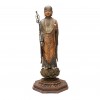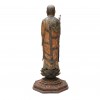
Bodhisattva Kshitigarbha (Jizō Bosatsu)

Photography by Synthescape, Digital image © Asia Society

Photography by Synthescape, Digital image © Asia Society
Zen'en
Bodhisattva Kshitigarbha (Jizō Bosatsu)
ca.1225–1226
Japan
Cypress wood with cut gold leaf and traces of pigment; staff with metal attachments
H. 22 3/4 x W. 9 1/2 x D. 9 1/2 in. (57.8 x 24.1 x 24.1 cm)
Asia Society, New York: Mr. and Mrs. John D. Rockefeller 3rd Collection, 1979.202a-e
Licensing inquiries
Jizō Bosatsu is worshiped as a savior bodhisattva who will help the devoted during the age of decay of the Buddhist teachings -- before the coming of Maitreya, the Buddha of the Future. Jizō is usually depicted as a Buddhist monk with a shaved head and monk's staff in his right hand. He holds a jewel of wisdom, which grants all wishes, in his left hand. In Japan, Jizō is also widely worshiped as the protector of women, ailing children, aborted fetuses, and of travelers. The deity's childlike image encourages the parent to see him alternately as an innocent child and a gentle savior figure. For travelers, stone statues of this bodhisattva are often placed at crossroads. The carving and decoration of his clothing with cut gold leaf (kirikane) is carefully designed to show the differences between the skirt, vest, and shawl. The use of borders to divide the shawl into different areas refers to the fact that originally a monk's garment was to be pieced together from fragments of cloth.
When this sculpture was repaired in the early 1960s, it was discovered that inscriptions, mostly the names of the donors or pious wishes, are written in black ink all over the hollow interior of its body and head. Among them are the names of the sculptor, Zen'en and the names of two prominent monks at the Kofukuji, which suggest that this sculpture was made for that temple. The inscriptions refer to Jisson as the abbot and Han'en as the former abbot. Temple records indicate that these two monks held those positions from 1223 to 1226, thereby providing a date for this sculpture. This date fits in well with the known activity of Zen'en, whose work includes sculptures that date from 1221 to 1247.


